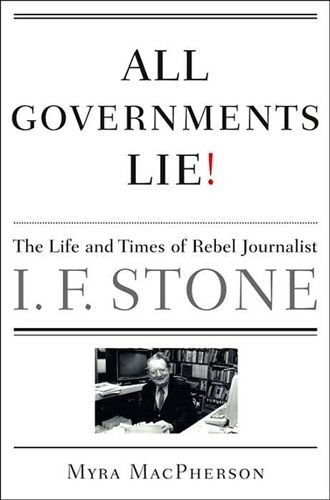| All Governments Lie: The Life and Times of Rebel Journalist I. F. Stone By Myra MacPherson Scribner $35.00, 564 pages |
I. F. Stone, born Isador Feinstein in Philadelphia in 1907, remains a name to inspire faith in the force of one voice speaking truth to power. The son of struggling European immigrants, he began exposing and opposing bigotry and oppression when he founded his own newspaper at age 14. By the time of his death, in 1989 at age 81, Stone had become the elder statesman of American scourges, a gadfly in the ointment of frauds and despots. With dense eyeglasses, feeble hearing, and a short, squat frame, Stone, who described himself as “a Jewish bullfrog,” seemed an unlikely adversary of mighty governments and corporations. Yet he earned the enmity of J. Edgar Hoover, whom he dissed as “a glorified Dick Tracy,” and became the object of surveillance not only by the FBI but also the CIA, United States Army, State Department, and Postal Service.
Tracing his career through six decades, Myra MacPherson, a former correspondent for the Washington Post, recapitulates the great events and causes to which Stone bore impassioned witness — the Depression, fascism, Stalinism, Spanish Civil War, World War II, Korean War, McCarthyism, civil rights, Vietnam, Iran-Contra, Reagonomics. An erudite autodidact, who took up ancient Greek in the final years of his life, he was cantankerous and egotistical but utterly obsessed with his mission of discovering and disseminating the truth. He wrote, indefatigably, for publications including the Philadelphia Inquirer, New York Post, The Nation, New York Review of Books, and PM, a scrappy leftist daily that accepted no advertising. PM folded after less than a decade, and when Stone found himself, during the repressive 1950s, unemployable, he founded an independent one-man operation, I. F. Stone’s Weekly, which he sustained with his own energies and talents from 1953-71.
Wary of trading honesty for access, Stone was the antithesis of an “embedded” journalist. “If you want to know about governments,” he warned, when George W. Bush was still a shrub, “all you have to know is two words, ‘governments lie.’” He prided himself on slighting press releases and doing the solid research necessary to uncover how American corporations were enriching themselves in Germany in 1941, how the 1964 Gulf of Tonkin incident was a sham, and how National Guard actions at Kent State University in 1970 constituted a slaughter of the innocents. He was an outsider who refused to feign detachment; he wrote as a partisan intent on being thorough and convincing. Though Stone was committed to advancing the causes of social and economic justice (he resigned from the National Press Club in 1941 when his guest, the dean of Howard University Law School, a black man, was denied service), he antagonized some on the left by critiquing Stalinism. A witness to the arduous journey by Holocaust survivors to the British Middle East, he alienated many with his strong support both of Israel and Palestinian rights.
Nothing testifies as much to the rancor that Stone, who wrote against labor exploitation, Jim Crow, government secrecy, militarism, and corporate greed, aroused on the right than a current campaign to besmirch his posthumous reputation. In conclusive detail, including testimony from a former Soviet spy best positioned to know, MacPherson refutes the scurrilous claim that Stone, who detested tyrannical regimes such as the Soviet Union, served the Kremlin as a covert informer.
MacPherson knew Stone, called “Izzy” by intimates, and, for all his tics and irritants, clearly continues to admire him. In constructing his biography, which is necessarily also a history of dissident American journalism through much of the 20th century, she offers British publisher Lord Norcliff’s definition of news as a justification for I. F. Stone’s life: “News is something someone wants to suppress. Everything else is advertising.”
Throughout her book, published 17 years after the death of its subject, MacPherson is acutely aware that, in an era of media consolidation, American imperialism, widening inequality, and government surveillance, Stone’s example of principled dissidence is more timely than ever. What would Izzy say: About mainstream media coopted as apologists for an unnecessary war? About a government that is corrupt, incompetent, and deceitful? About the elevation of greed into a civic virtue? About the assault on the First Amendment? Except for some intrepid alternative publications and a few novae in the blogosphere, corporate infotainment has displaced responsible independent journalism. For the health of our democracy, everybody must get Stoned.

















